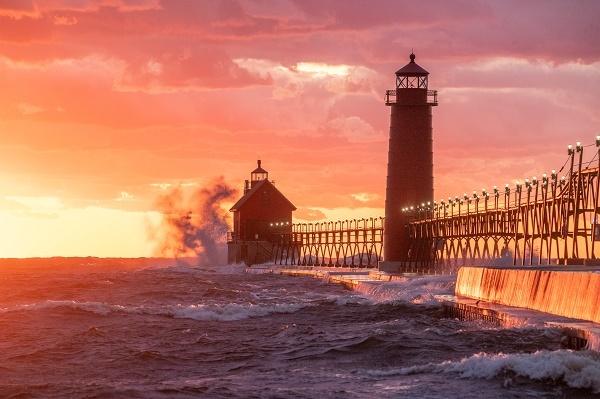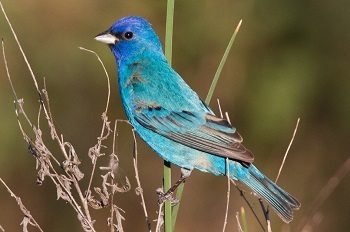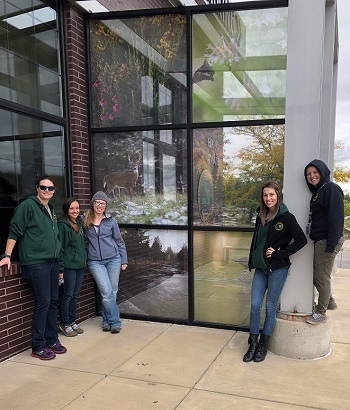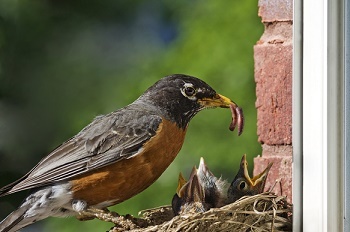|
This week's stories may reflect how the Department of Natural Resources has adapted to meet customer needs and protect public health and safety. Follow our COVID-19 response page for updates on access to facilities and programs.
We'll continue to share news and information about the best ways to discover and enjoy Michigan's natural and heritage resources! Here's a look at some of this week's stories:
See other news releases, Showcasing the DNR stories, photos and other resources at Michigan.gov/DNRPressRoom.
PHOTO FOLDER: Larger, higher-res versions of some of the images used below, and others, are available in this folder.
 Want to see more pictures like this, taken by Michigan state parks photo ambassador Blair Celano at Grand Haven State Park in Ottawa County? Visit Instagram.com/MiStateParks to explore photos and learn more about the photo ambassadors! For more on the photo ambassador program, call Stephanie Yancer at 989-274-6182.

With warming spring temperatures right around the corner for much of the state, it’s a good time to remind everyone to help protect trails. Using muddy trails can leave ruts, uneven tire tracks and footprints, contribute to erosion and inadvertently widen trails.
It’s best to avoid muddy trails altogether; however, if you do encounter muddy sections, please keep the following tips in mind to avoid widening the trails:
- When bike riding: Dismount and tiptoe down the center – not the sides – of the trail.
- When hiking: Go right through the center of the trail, rather than traveling around the mud.
- When horseback riding: Carefully travel with your horse through the center of the trail.
“Following these tips may mean a little more cleanup for shoes, tires and hooves after an outing, but I think most trail users would agree it’s worth it to ensure our trails stay in the best possible condition during this seasonal transition,” said Kristen Bennett, acting state trails coordinator for the DNR Parks and Recreation Division. “Plus, when trails do start to widen, it can pose safety risks to users and cause damage to surrounding wildlife habitat.”
Learn more about etiquette on nonmotorized trails at Michigan.gov/DNRTrails.
Questions? Contact Kristen Bennett at BennettK@Michigan.gov.
|

The Great Lakes lie at the intersection of two migratory flyways, or superhighways, which bring over 350 bird species through the region each spring. While a beautiful spectacle for us, migration is a harrowing journey for birds. One of the biggest dangers they face? Collisions with windows and other glass surfaces.
Migrating songbirds like indigo buntings and Swainson’s thrushes are at highest risk of building collisions. These species also face steep population declines; doing what we can to prevent window collisions will help ensure their survival. (This photo of an indigo bunting is by photographer Dan Pancamo.)
Collisions with human-made structures are a leading cause of bird deaths in the United States, causing up to 1 billion bird deaths each year in North America. Birds cannot detect glass, and collisions are just as likely regardless of bird health or age.
When birds hit windows, it is a life-threatening occurrence. Even birds that are able to fly away are likely to succumb to their injuries later. The good news is that there are opportunities to make your home or office more bird-friendly:
|

-
Identify problematic windows. To see which windows have caused collisions, check them from outside two or three times a week. Look for imprints, smudges or feathers on the glass, injured or dead birds, or clumps of feathers within 6-8 feet of the glass.
-
Install bird-friendly solutions. Patterns on the outside surface of glass are the best way to reduce collisions. Studies have shown that exterior window patterns should be about 2-4 inches apart; 2x2-inch spacing is even better for smaller species, like Michigan’s ruby-throated hummingbirds, which are more prone to window-collisions.
For a list of quick, affordable ways to protect birds from your windows, check out American Bird Conservancy’s bird-friendly windows flyer and bird-friendly products database, Animal Help Now’s flyer on preventing bird window strikes and Audubon’s resources on reducing collisions with glass. Learn about Audubon’s Lights Out Program and how to make your hometown safer for migratory birds.
For information on how you can get involved in Safe Passage Great Lakes building monitoring efforts, and what to do if you find a window-collision survivor, visit the Audubon Great Lakes website.
|

Thrilling ORV rides, outdoor exploring and forest adventures are waiting down one of Michigan’s thousands of miles of state forest roads. Every year, the DNR updates maps of these roads to improve accuracy and protect the environment, and then notifies the public of any changes. New maps go up at Michigan.gov/ForestRoads Friday, April 1, in an interactive web format and as printable PDF maps.
Map changes are based on considerations that include changing road conditions, data cleanup and input received from residents around the state. Maps show where state forest roads are open or closed to off-road vehicle use and which roads are only open to conventional vehicles. It’s important to stay on these roads when using motor vehicles to reduce erosion and damage to wildlife habitat.
The following mileages will be open to ORVs starting April 1:
- In the Upper Peninsula, about 5,498 miles – roughly 98% of the total 5,594 miles.
- In the northern Lower Peninsula, about 6,205 miles – roughly 85% of the total 7,317.2 miles.
- In the southern Lower Peninsula, more than 9 miles – roughly 2.5% of the total 370.9 miles.
|
Trial access at Camp Grayling
New this year is a trial opening to ORV use of nearly 95 miles of forest roads located within the Camp Grayling training area in Crawford County. The roads, located on 16,000 acres of state forest lands leased from the DNR for military training, are north of County Road 612 near the city of Grayling.
The forest roads will be open to the public when not in use for military training. When the area is used for training activities, roads will be gated off for public safety. Notice will be posted on the Camp Grayling Joint Maneuver Training Center Facebook page and shared on local radio stations.
Review ORV rules, regulations, closures and more at Michigan.gov/ORVInfo. Find maps and other information at Michigan.gov/ForestRoads.
Questions? Contact Jason Caron at 906-235-4361.

Spring brings a new generation of wildlife and plenty of opportunities for people to observe these natural wonders. While you’re enjoying the season, be sure to give wildlife lots of space to raise their babies. Also, don’t be surprised to see young animals on their own.
"As we get into spring and summer you might see fledgling birds hopping around on the ground. This is completely normal," said Hannah Schauer, wildlife communications coordinator with the DNR. "These fluffy youngsters are getting ready to start trying to fly and need more space than nests provide. The adults aren't far and will continue to feed and care for their young."
In addition to birds, you might see other young animals left alone, but the parents are nearby. This is especially true for rabbits and fawns.
|
"One survival strategy wild mammal moms may use is hiding their young while they are elsewhere," said Schauer. "This tactic helps young animals stay safer from predators because mom leaves and pulls the attention away from where they’re hidden."
Eventually, the youngsters will be strong and fast enough to venture out on their own or accompany their mother.
No matter where you find them, never remove animals from the wild. Young animals rarely are abandoned and their best chance for survival is to remain in the wild.
Only licensed wildlife rehabilitators may possess abandoned or injured wildlife. Unless a person is properly licensed, it is illegal to possess a live, wild animal in Michigan.
Learn more about what to do if you find a baby animal at Michigan.gov/Wildlife or contact the DNR Wildlife Division at 517-284-9453.
|